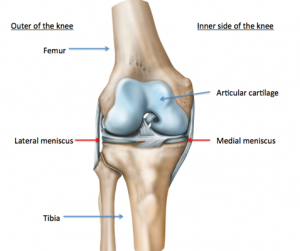Pain in the knee with twisting or bending? – Often a torn meniscus…
The two menisci are the rubbery shock absorber cartilages that sit inside the knee. Not to be confused with the smooth articular cartilage that lines the ends of the bones in the joint. There is a medial meniscus on the inside of the knee, and a lateral meniscus on the outside of the knee. Either can become torn.

When we are young these menisci and strong, and to tear them required a significant and memorable injury. As we get older the menisci get stiffer and more fragile and can tear with only a minor injury, which may go unnoticed. It may help to think of this process in terms of the difference between a new rubber car tyre, versus a perished older tyre which splits much more easily. For this reason, older patients may tear their meniscus without having a very significant injury and it is common to get knee pain ‘out of the blue’ from a degenerate meniscal tear.
Pain is felt within the knee joint often on the inside or outside of the knee towards the back. The knee may or may not swell and may be painful to walk on. You may notice sharp pains in certain positions, clicking, locking or giving way of the knee. Twisting can be bad. The knee may ache at rest or at night time.
Older patients often have a torn meniscus as well as some early arthritis in the knee and the two can give a mixed picture of symptoms. Usually problems arising for the meniscus come on fairly quickly over a matter of weeks and don’t fully settle down. Arthritis pain gradually builds up over months and years.
If you think you have a torn meniscus it is well worth getting it checked out by Dr. Amit . It is important to treat the early phase with rest, ice, compression and elevation in order to minimise the bleeding and swelling. You should avoid any aggravating activities. Meniscal tears very rarely get better on their own, and surgery is usually required. The sooner this is done the better.
Treatment involves first confirming the diagnosis usually by a careful examination and an MRI scan, this is useful to tell how much of your problems are from a torn meniscus and how much early arthritis is present. Once the diagnosis is certain keyhole surgery will be required to trim the damaged part of the meniscus. This will be followed by a carefully directed graduated physiotherapy program.
See the information sheets about knee arthroscopy.
